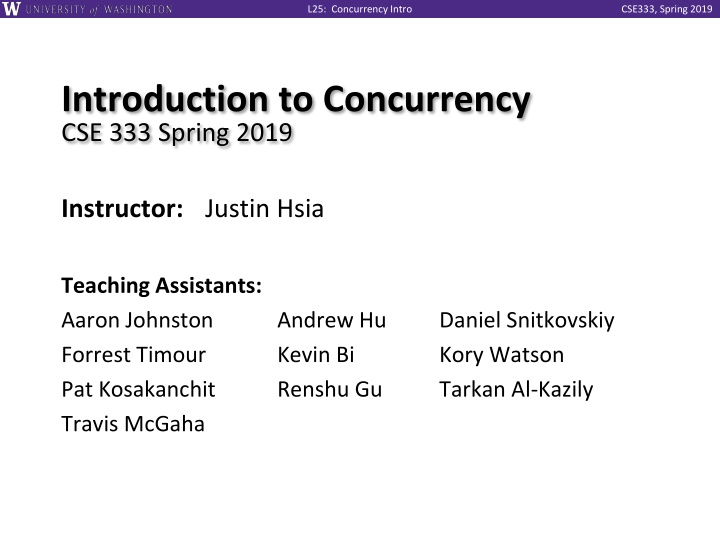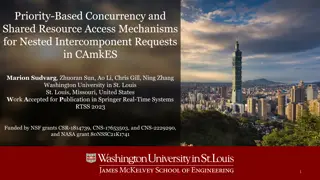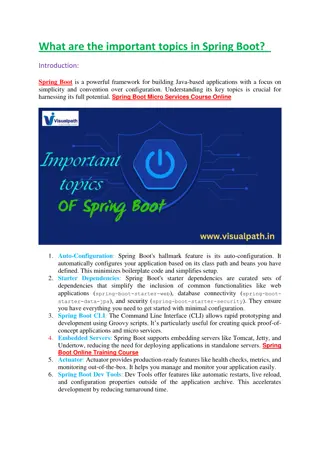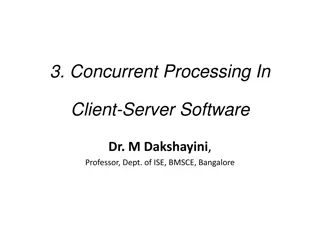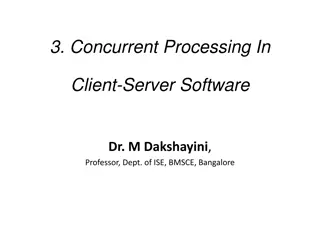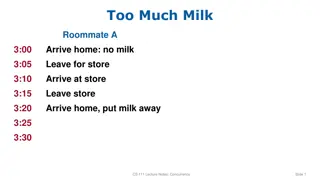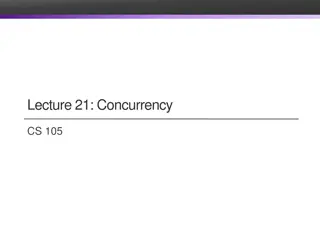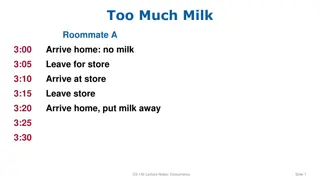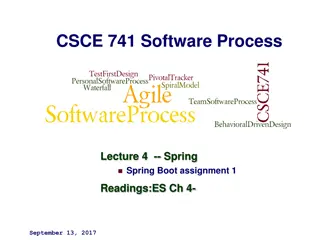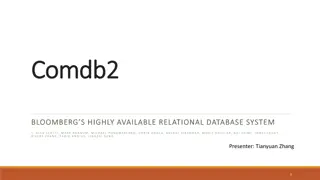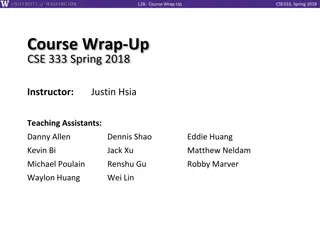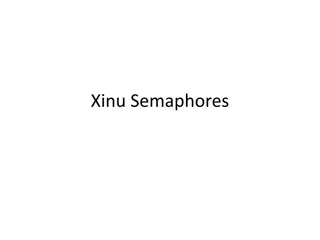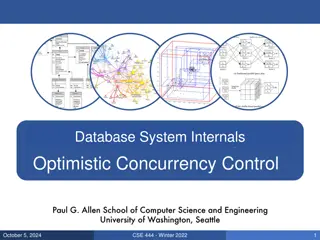Introduction to Concurrency in CSE333 Spring 2019
This material covers the basics of concurrency, highlighting its importance and challenges in programming. It touches on different programming styles, such as threads vs. processes, and explores building a web search engine, focusing on the web index, query processing, and search server architecture in the context of CSE333 in Spring 2019.
Download Presentation

Please find below an Image/Link to download the presentation.
The content on the website is provided AS IS for your information and personal use only. It may not be sold, licensed, or shared on other websites without obtaining consent from the author.If you encounter any issues during the download, it is possible that the publisher has removed the file from their server.
You are allowed to download the files provided on this website for personal or commercial use, subject to the condition that they are used lawfully. All files are the property of their respective owners.
The content on the website is provided AS IS for your information and personal use only. It may not be sold, licensed, or shared on other websites without obtaining consent from the author.
E N D
Presentation Transcript
L25: Concurrency Intro CSE333, Spring 2019 Introduction to Concurrency CSE 333 Spring 2019 Instructor: Justin Hsia Teaching Assistants: Aaron Johnston Forrest Timour Pat Kosakanchit Travis McGaha Andrew Hu Kevin Bi Renshu Gu Daniel Snitkovskiy Kory Watson Tarkan Al-Kazily
L25: Concurrency Intro CSE333, Spring 2019 Administrivia hw4 due next Thursday (6/6) Yes, can still use one late day on hw4 Exercise 17 (last one!) released Monday, due Wednesday Concurrency via pthreads Final is Wednesday (6/12), 12:30-2:20 pm, ARC 147 Review Session: Sunday (6/9), 4-6:30 pm, ECE 125 Reference sheet was passed out in section yesterday, also available on course website Two double-sided, handwritten sheets of notes allowed Topic list and past finals on Exams page on website 2
L25: Concurrency Intro CSE333, Spring 2019 Some Common hw4 Bugs Your server works, but is really, really slow Check the 2nd argument to the QueryProcessor constructor Funny things happen after the first request Make sure you re not destroying the HTTPConnection object too early (e.g. falling out of scope in a while loop) Server crashes on a blank request Make sure that you handle the case that read() (or WrappedRead()) returns 0 3
L25: Concurrency Intro CSE333, Spring 2019 Outline Understanding Concurrency Why is it useful Why is it hard Concurrent Programming Styles Threads vs. processes Non-blocking I/O Search Server Revisited 4
L25: Concurrency Intro CSE333, Spring 2019 Building a Web Search Engine We need: A web index A map from <word> to <list of documents containing the word> This is probably sharded over multiple files A query processor Accepts a query composed of multiple words Looks up each word in the index Merges the result from each word into an overall result set 5
L25: Concurrency Intro CSE333, Spring 2019 Web Search Architecture client index file client index file query processor client client index file client 6
L25: Concurrency Intro CSE333, Spring 2019 Sequential Implementation Pseudocode for sequential query processor: doclist Lookup(string word) { bucket = hash(word); hitlist = file.read(bucket); foreach hit in hitlist { doclist.append(file.read(hit)); } return doclist; } main() { while (1) { string query_words[] = GetNextQuery(); results = Lookup(query_words[0]); foreach word in query[1..n] { results = results.intersect(Lookup(word)); } Display(results); } } 7
L25: Concurrency Intro CSE333, Spring 2019 Sequential Execution Timeline results.intersect() network I/O network I/O GetNextQuery() file.read() file.read() file.read() GetNextQuery() disk I/O disk I/O disk I/O Display() Lookup() Lookup() Lookup() main() time query 8
L25: Concurrency Intro CSE333, Spring 2019 Sequential Queries Simplified CPU 3.a I/O 3.b CPU 3.c I/O 3.d CPU 3.e CPU 2.a I/O 2.b CPU 2.c I/O 2.d CPU 2.e query 3 CPU 1.e CPU 1.a I/O 1.b CPU 1.c I/O 1.d query 2 query 1 time 9
L25: Concurrency Intro CSE333, Spring 2019 Sequential Queries Simplified Only one I/O request at a time is in flight CPU 3.a I/O 3.b CPU 3.c I/O 3.d CPU 3.e The CPU is idle most of the time! CPU 2.a I/O 2.b CPU 2.c I/O 2.d CPU 2.e query 3 CPU 1.e CPU 1.a I/O 1.b CPU 1.c I/O 1.d query 2 Queries don t run until earlier queries finish query 1 time 10
L25: Concurrency Intro CSE333, Spring 2019 Sequential Can Be Inefficient Only one query is being processed at a time All other queries queue up behind the first one The CPU is idle most of the time It is blocked waiting for I/O to complete Disk I/O can be very, very slow At most one I/O operation is in flight at a time Missed opportunities to speed I/O up Separate devices in parallel, better scheduling of a single device, etc. 11
L25: Concurrency Intro CSE333, Spring 2019 Concurrency A version of the program that executes multiple tasks simultaneously Example: Our web server could execute multiple queries at the same time While one is waiting for I/O, another can be executing on the CPU Example: Execute queries one at a time, but issue I/O requests against different files/disks simultaneously Could read from several index files at once, processing the I/O results as they arrive Concurrency != parallelism Parallelism is executing multiple CPU instructions simultaneously 12
L25: Concurrency Intro CSE333, Spring 2019 A Concurrent Implementation Use multiple threads or processes As a query arrives, fork a new thread (or process) to handle it The thread reads the query from the console, issues read requests against files, assembles results and writes to the console The thread uses blocking I/O; the thread alternates between consuming CPU cycles and blocking on I/O The OS context switches between threads/processes While one is blocked on I/O, another can use the CPU Multiple threads I/O requests can be issued at once 13
L25: Concurrency Intro CSE333, Spring 2019 Introducing Threads Separate the concept of a process from an individual thread of control Usually called a thread (or a lightweight process), this is a sequential execution stream within a process thread In most modern OS s: Process: address space, OS resources/process attributes Thread: stack, stack pointer, program counter, registers Threads are the unit of scheduling and processes are their containers; every process has at least one thread running in it 14
L25: Concurrency Intro CSE333, Spring 2019 Multithreaded Pseudocode main() { while (1) { string query_words[] = GetNextQuery(); ForkThread(ProcessQuery()); } } doclist Lookup(string word) { bucket = hash(word); hitlist = file.read(bucket); foreach hit in hitlist doclist.append(file.read(hit)); return doclist; } ProcessQuery() { results = Lookup(query_words[0]); foreach word in query[1..n] results = results.intersect(Lookup(word)); Display(results); } 15
L25: Concurrency Intro CSE333, Spring 2019 Multithreaded Queries Simplified I/O 3.d CPU 3.a I/O 3.b CPU 3.c CPU 3.e query 3 CPU 2.a I/O 2.b CPU 2.c I/O 2.d CPU 2.e query 2 CPU 1.a I/O 1.b CPU 1.c I/O 1.d CPU 1.e query 1 time 16
L25: Concurrency Intro CSE333, Spring 2019 Why Threads? Advantages: You (mostly) write sequential-looking code Threads can run in parallel if you have multiple CPUs/cores Disadvantages: If threads share data, you need locks or other synchronization Very bug-prone and difficult to debug Threads can introduce overhead Lock contention, context switch overhead, and other issues Need language support for threads 17
L25: Concurrency Intro CSE333, Spring 2019 Alternative: Processes What if we forked processes instead of threads? Advantages: No shared memory between processes No need for language support; OS provides fork Disadvantages: More overhead than threads during creation and context switching Cannot easily share memory between processes typically communicate through the file system 18
L25: Concurrency Intro CSE333, Spring 2019 Alternate: Different I/O Handling Use asynchronous or non-blocking I/O Your program begins processing a query When your program needs to read data to make further progress, it registers interest in the data with the OS and then switches to a different query The OS handles the details of issuing the read on the disk, or waiting for data from the console (or other devices, like the network) When data becomes available, the OS lets your program know Your program (almost never) blocks on I/O 19
L25: Concurrency Intro CSE333, Spring 2019 Non-blocking I/O Reading from the network can truly block your program Remote computer may wait arbitrarily long before sending data Non-blocking I/O (network, console) Your program enables non-blocking I/O on its file descriptors Your program issues read() and write() system calls If the read/write would block, the system call returns immediately Program can ask the OS which file descriptors are readable/writeable Program can choose to block while no file descriptors are ready 20
L25: Concurrency Intro CSE333, Spring 2019 Outline (next two lectures) We ll look at different searchserver implementations Sequential Concurrent via dispatching threads pthread_create() Concurrent via forking processes fork() Reference: Computer Systems: A Programmer s Perspective, Chapter 12 (CSE 351 book) 21
L25: Concurrency Intro CSE333, Spring 2019 Sequential Pseudocode: listen_fd = Listen(port); while (1) { client_fd = accept(listen_fd); buf = read(client_fd); resp = ProcessQuery(buf); write(client_fd, resp); close(client_fd); } See searchserver_sequential/ 22
L25: Concurrency Intro CSE333, Spring 2019 Why Sequential? Advantages: Super(?) simple to build/write Disadvantages: Incredibly poor performance One slow client will cause all others to block Poor utilization of resources (CPU, network, disk) 23
L25: Concurrency Intro CSE333, Spring 2019 Threads Threads are like lightweight processes They execute concurrently like processes Multiple threads can run simultaneously on multiple CPUs/cores Unlike processes, threads cohabitate the same address space Threads within a process see the same heap and globals and can communicate with each other through variables and memory But, they can interfere with each other need synchronization for shared resources Each thread has its own stack 24
L25: Concurrency Intro CSE333, Spring 2019 Threads and Address Spaces OS kernel [protected] Before creating a thread One thread of execution running in the address space Stackparent SPparent One PC, stack, SP That main thread invokes a function to create a new thread Typically pthread_create() Shared Libraries Heap (malloc/free) Read/Write Segment .data, .bss Read-Only Segment .text, .rodata PCparent 25
L25: Concurrency Intro CSE333, Spring 2019 Threads and Address Spaces OS kernel [protected] After creating a thread Two threads of execution running in the address space Stackparent SPparent Stackchild Original thread (parent) and new thread (child) SPchild New stack created for child thread Shared Libraries Child thread has its own values of the PC and SP Both threads share the other segments (code, heap, globals) Heap (malloc/free) Read/Write Segment .data, .bss They can cooperatively modify shared data Read-Only Segment .text, .rodata PCchild PCparent 26
L25: Concurrency Intro CSE333, Spring 2019 POSIX Threads (pthreads) The POSIX APIs for dealing with threads Part of the standard C/C++ libraries, declared in pthread.h To enable support for multithreading, must include -pthread flag when compiling and linking with gcc command 27
L25: Concurrency Intro CSE333, Spring 2019 Creating and Terminating Threads int pthread_create( pthread_t* thread, const pthread_attr_t* attr, void* (*start_routine)(void*), void* arg); Creates a new thread, whose identifier is place in *thread, with attributes *attr (NULL means default attributes) Returns 0 on success and an error number on error (can check against error constants) The new thread runs start_routine(arg) void pthread_exit(void* retval); Equivalent of exit(retval); for a thread instead of a process The thread will automatically exit once it returns from start_routine() 28
